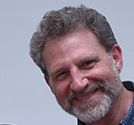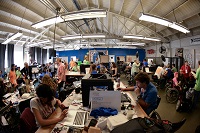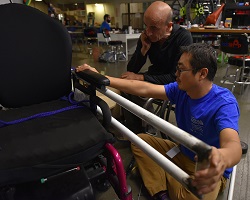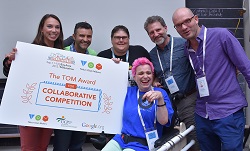Date: Wednesday, November 11, 2015
Category: Member News
 Editor’s Note: The Maker Movement and the development of cheaper 3D printing have inspired a lot of discussion in the RESNA community about the possibilities for assistive technology product development. RESNA member Ronny Gaal, a rehabilitation engineer at San Francisco State University, attended the Bay Area Makeathon on September 11-13 at TechShop San Francisco, which was sponsored by United Cerebral Palsy, Google.org, and TOM Global (Tikkun Olam Makers). This is an edited transcript of a phone interview.
Editor’s Note: The Maker Movement and the development of cheaper 3D printing have inspired a lot of discussion in the RESNA community about the possibilities for assistive technology product development. RESNA member Ronny Gaal, a rehabilitation engineer at San Francisco State University, attended the Bay Area Makeathon on September 11-13 at TechShop San Francisco, which was sponsored by United Cerebral Palsy, Google.org, and TOM Global (Tikkun Olam Makers). This is an edited transcript of a phone interview.

On Friday morning I showed up at
TechShop in San Francisco, which has an impressive range of tools, large and small. There were also a dozen or so 3D printers supplied by
MakerBot, with support people on hand. Since I came in as a floater, the personnel organizer from TOM gave me a short list of teams that might fit my skills. So I cruised around meeting those teams, and then started with one that was working on a self-feeding device. That afternoon, I investigated a few other projects and then joined a team working on a transfer device for a woman with CP that rides a powered wheelchair. My decision was as much about the people as the project. The transfer device team really welcomed my participation, and the social dynamics within the group seemed very positive.
Our team was so busy that we didn’t have much time to get to know each other's backgrounds. I did learn that the rest of my teammates all work at Google, but in different departments. Our project leader, Mariah, works in the disability world as an AT researcher. I think she’s involved in Google’s effort to come up with new AT products that they might want to develop. Another teammate, Vincent, was a paraplegic manual wheelchair rider. He was also consulting for another Makeathon team, but was on hand for most of the strategy and design discussions. I was the only one with AT service delivery experience.
It’s an extremely compressed process. You figure out what to do, how to do it, and then create a prototype. Our consumer, Shari, didn’t have the stamina to be available for very long. We would have an hour-long meeting maybe two times each day where we could try something with her, then she’d have to rest. Luckily, she arrived with two wheelchairs – her powered wheelchair and a manual wheelchair. So we borrowed her powered wheelchair for the fabrication process.

My team was typical of the 18 teams at the event, mixing ‘makers’ who didn’t have much knowledge of AT and disability world, with ‘need knowers’ who knew a lot. But I don’t think there were many AT professionals in attendance, and in some teams the only ‘need knower’ was the client who had proposed the tech challenge. In my group I was active as both a need knower and maker. The fact that I’ve had a lot of exposure to people with disabilities, wheelchairs, and the real-world aspects of how AT is a part of a tech and caregiver ecosystem was helpful. Also, I have a mechanical engineering background, and we were doing low-tech design and fabrication, so my skills were a good match.
Up until Saturday evening, we were still struggling with design. After we settled into a design and shopped for materials, it still changed radically, a couple of times. When we began fabrication, my making skills were right for that as well. Part of the joy of the event for me personally was that I got to use a range of my skills.
We worked on a way to help our consumer safely get in and out of her new powered wheelchair. Her chair is too high, in my opinion, but it’s a new chair and she’s going to have it for a while. We designed a wheelchair-mounted transfer grab bar that worked pretty well. Now she can get out of the chair independently, but not into it – she’s short. She really needs another two components, a short ramp and a stirrup, which would allow her to climb up and push herself into the chair better, but we didn’t have enough time to tackle those.
TechShop was open 24/7 starting Friday morning. People from TOM Global were on hand to support us however they could, including help with design, shopping, fabrication, and matchmaking with other people at the event who had skills in demand. They fed us and allowed us to stay all we wanted. My strategy was to go home on Friday night and sleep a bit, so I could potentially stay overnight Saturday if we needed it – and we did. I worked all night. I am 55, so I do not do all-nighters anymore; but to be on a team and just stay focused and keep working, not to mention in a fabulous machine shop, was just ridiculously fun. It really gives you a lot of energy to be allowed to just be there and shut out distractions and do one project.

Sunday at around noon was the deadline, and then judging started. During the final work hours, our team leader had put together a PowerPoint presentation to show the development process to the judges. My team won the Collaborative Competition Award, which is voted on by other teams. So that was really special, because it was a reflection of what our neighbors were seeing, and corroborated our experience.
The nature of what we designed might be too specific to our consumer to replicate for others. I really admired a product from another team, a door opener device that a wheelchair rider can use on doors that have spring-powered closers. It helps hold the door open while the wheelchair is going through. That team received the Inclusion Award from UCP.
As I was leaving, one of the TOM Global organizers asked me what I thought of the makeathon model for developing new products. I said as a service delivery person, I don’t know that much about how products are brought to market, but I thought anything that could generate that much communication between relative strangers, and that much focus and excitement around AT, has got to be a good thing.
I think the Maker Movement is a really attractive angle on how AT could be developed. A lot of what happens in AT is creating products that have to serve a whole range of people, but then there’s the issue of custom one-off stuff. I think makers can have a role in both spheres. Based upon this experience I would like to see more RESNA members get involved in future Makeathons, and I recommend it.